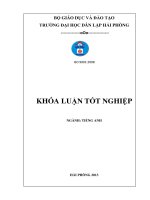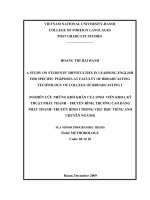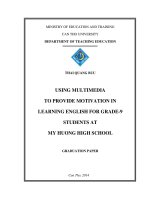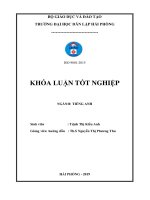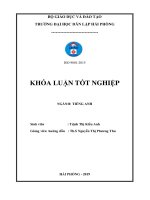Difficulties in learning english idioms of students at faculties of foreign languages and some suggested solutions
Bạn đang xem bản rút gọn của tài liệu. Xem và tải ngay bản đầy đủ của tài liệu tại đây (1.43 MB, 52 trang )
BỘ GIÁO DỤC VÀ ĐÀO TẠO
TRƯỜNG ĐẠI HỌC DÂN LẬP HẢI PHÒNG
-------------------------------
ISO 9001:2015
KHÓA LUẬN TỐT NGHIỆP
NGÀNH: TIẾNG ANH
Sinh viên
: Trịnh Thị Kiều Anh
Giảng viên hướng dẫn : Th.S Nguyễn Thị Phương Thu
HẢI PHÒNG - 2019
MINISTRY OF EDUCATION AND TRANING
HAIPHONG PRIVATE UNIVERSITY
-----------------------------------
DIFFICULTIES IN LEARNING ENGLISH IDIOMS OF
STUDENTS AT FACULTIES OF FOREIGN LANGUAGE AND
SOME SUGGESTED SOLUTIONS
GRADUATION PAPER
Student
: Trinh Thi Kieu Anh
Class
: NA1804
Supervisor
: Nguyen Thi Phuong Thu, M.A
HAI PHONG - 2019
BỘ GIÁO DỤC VÀ ĐÀO TẠO
TRƯỜNG ĐẠI HỌC DÂN LẬP HẢI PHÒNG
--------------------------------------
NHIỆM VỤ ĐỀ TÀI TỐT NGHIỆP
Sinh viên: Trịnh Thị Kiều Anh
Lớp: NA1804
Mã SV: 1412751127
Ngành: Ngoại ngữ
Tên đề tài: Difficulties in learning English idioms of students at faculties of
foreign languages and some suggested solutions.
NHIỆM VỤ ĐỀ TÀI
1. Nội dung và các yêu cầu cần giải quyết trong nhiệm vụ đề tài tốt nghiệp
( về lý luận, thực tiễn, các số liệu cần tính toán và các bản vẽ).
.........................................................................................................................
.........................................................................................................................
.........................................................................................................................
.........................................................................................................................
.........................................................................................................................
2. Các số liệu cần thiết để thiết kế, tính toán.
.........................................................................................................................
.........................................................................................................................
.........................................................................................................................
.........................................................................................................................
.........................................................................................................................
3. Địa điểm thực tập tốt nghiệp.
.........................................................................................................................
.........................................................................................................................
.........................................................................................................................
.........................................................................................................................
.........................................................................................................................
CÁN BỘ HƯỚNG DẪN ĐỀ TÀI TỐT NGHIỆP
Người hướng dẫn thứ nhất:
Họ và tên: Nguyễn Thị Phương Thu
Học hàm học vị: Thạc sĩ
Cơ quan công tác: Đại học Dân lập Hải Phòng
Nội dung hướng dẫn: Difficulties in learning English idioms of students at
faculties of foreign languages some suggested solutions.
Người hướng dẫn thứ hai:
Họ và tên:.............................................................................................
Học hàm, học vị:...................................................................................
Cơ quan công tác:.................................................................................
Nội dung hướng dẫn:............................................................................
Đề tài tốt nghiệp được giao ngày 03 tháng 01 năm 2019
Yêu cầu phải hoàn thành xong trước ngày 00 tháng 00 năm 2019
Đã nhận nhiệm vụ ĐTTN
Sinh viên
Đã giao nhiệm vụ ĐTTN
Người hướng dẫn
Hải Phòng, ngày ...... tháng........năm 2019
Hiệu trưởng
GS.TS.NGƯT Trần Hữu Nghị
PHẦN NHẬN XÉT CỦA CÁN BỘ HƯỚNG DẪN
1. Tinh thần thái độ của sinh viên trong quá trình làm đề tài tốt nghiệp:
.........................................................................................................................
.........................................................................................................................
.........................................................................................................................
.........................................................................................................................
.........................................................................................................................
2. Đánh giá chất lượng của khóa luận (so với nội dung yêu cầu đã đề ra trong
nhiệm vụ Đ.T. T.N trên các mặt lý luận, thực tiễn, tính toán số liệu…):
.........................................................................................................................
.........................................................................................................................
.........................................................................................................................
.........................................................................................................................
.........................................................................................................................
3. Cho điểm của cán bộ hướng dẫn (ghi bằng cả số và chữ):
.........................................................................................................................
.........................................................................................................................
.........................................................................................................................
.........................................................................................................................
Hải Phòng, ngày … tháng … năm
Cán bộ hướng dẫn
(Ký và ghi rõ họ tên)
CỘNG HÒA XÃ HỘI CHỦ NGHĨA VIỆT NAM
Độc lập - Tự do - Hạnh phúc
PHIẾU NHẬN XÉT CỦA GIẢNG VIÊN HƯỚNG DẪN TỐT NGHIỆP
Họ và tên giảng viên:
...................................................................................................
Đơn vị công tác:
........................................................................
..........................
Họ và tên sinh viên:
Chuyên
..........................................
ngành:
...............................
Đề tài tốt nghiệp:
...................................................................................................
...........................................................
........................................
Nội dung hướng dẫn:
..........................................................
........................................
....................................................................................................................................
1. Tinh thần thái độ của sinh viên trong quá trình làm đề tài tốt nghiệp
..............................................................................................................................................
..............................................................................................................................................
..............................................................................................................................................
..............................................................................................................................................
..............................................................................................................................................
2. Đánh giá chất lượng của đồ án/khóa luận (so với nội dung yêu cầu đã đề ra trong
nhiệm vụ Đ.T. T.N trên các mặt lý luận, thực tiễn, tính toán số liệu…)
..............................................................................................................................................
..............................................................................................................................................
..............................................................................................................................................
..............................................................................................................................................
..............................................................................................................................................
..............................................................................................................................................
3. Ý kiến của giảng viên hướng dẫn tốt nghiệp
Được bảo vệ
QC20-B17
Không được bảo vệ
Điểm hướng dẫn
Hải Phòng, ngày … tháng … năm ......
Giảng viên hướng dẫn
(Ký và ghi rõ họ tên)
QC20-B17
CỘNG HÒA XÃ HỘI CHỦ NGHĨA VIỆT NAM
Độc lập - Tự do - Hạnh phúc
PHIẾU NHẬN XÉT CỦA GIẢNG VIÊN CHẤM PHẢN BIỆN
Họ và tên giảng viên:
..............................................................................................
Đơn vị công tác:
........................................................................
.....................
Họ và tên sinh viên:
......................................
Chuyên
ngành:
..............................
Đề tài tốt nghiệp:
.........................................................................
....................
............................................................................................................................
........
............................................................................................................................
........
1. Phần nhận xét của giáo viên chấm phản biện
..........................................................................................................................................
..........................................................................................................................................
..........................................................................................................................................
..........................................................................................................................................
..........................................................................................................................................
..........................................................................................................................................
2. Những mặt còn hạn chế
..........................................................................................................................................
..........................................................................................................................................
..........................................................................................................................................
..........................................................................................................................................
..........................................................................................................................................
..........................................................................................................................................
3. Ý kiến của giảng viên chấm phản biện
Được bảo vệ
Không được bảo vệ
Điểm phản biện
Hải Phòng, ngày … tháng … năm ......
Giảng viên chấm phản biện
(Ký và ghi rõ họ tên)
ACKNOWLEDGEMENT
First of all, I would like to express my gratitude to Miss Nguyen Thi
Phuong Thu, MA- the lecturer of foreign language faculty, Haiphong Private
University for her enthusiastic guidance, assistance and encouragement.
My sincere thanks go to all the teachers in Foreign Language Department
of Haiphong Private University for their endless enthusiast, valuable teaching
and tremendous assistance. I would also like to thank students of Haiphong
Private University who enthusiastically help me complete the survey
questionnaires.
Finally, I am very grateful to my family and all my friends who have
helped and given me many encouragements as well as supplied me with
materials during the time this graduation paper was done.
Hai Phong, March 2019
Trinh Thi Kieu Anh
TABLE OF CONTENTS
ACKNOWLEDGEMENT
TABLE OF CONTENTS
PART I: INTRODUCTION ................................................................................ 1
1. Rationale ......................................................................................................... 1
2. Aims of the study ............................................................................................ 1
3. Scope of the study ........................................................................................... 2
4. Methods of the study ....................................................................................... 2
5. Design of the study .......................................................................................... 2
PART II: DEVELOPMENT................................................................................ 4
CHAPTER 1: THEORETICAL BACKGROUND ............................................. 4
1.1.An overview of idioms .................................................................................. 4
1.1.1. Definitions of idioms ................................................................................. 4
1.1.2. Types of idioms.......................................................................................... 6
1.1.3. The importance of learning English idioms ............................................... 8
1.2.The characteristics of English idioms ............................................................ 8
1.2.2. Non-substitutability ................................................................................... 9
1.2.3. Non-modifiability....................................................................................... 9
1.2.4. Institutionalization ..................................................................................... 9
1.3. The distinctions between idioms and proverbs. .......................................... 10
1.3.1. English idioms and proverbs ................................................................... 10
1.3.2. Vietnamese idioms and proverbs ............................................................. 10
1.4. Popular idiom examples ............................................................................. 12
CHAPTER 2: SIMILARITIES AND DIFFERENCES BETWEEN ENGLISH
AND VIETNAMESE IDIOMS ......................................................................... 16
2.1. Similarities between English and Vietnamese idioms. ............................... 16
2.2. Differences between English and Vietnamese idioms ................................ 17
CHAPTER 3: FINDINGS AND DISCUSSION ............................................... 19
3.1. Survey questionnaires on difficulties in learning English idiom at HPU .... 19
3.1.1. Participants .............................................................................................. 19
3.1.2. Purpose of survey questionnaires ............................................................ 19
3.1.3. Data analysis............................................................................................ 19
3.2. Student’s difficulties when learning English idioms .................................. 24
3.2.1. The richness and diversity of the English idioms requires a sufficient
cultural background knowledge to fully comprehend and master them. ........... 24
3.2.2. English idioms can not easily be understood by defining their
components. ...................................................................................................... 25
3.2.3. Most of English idioms need to be understood basing on their figurative
meanings. .......................................................................................................... 25
3.2.4. English idioms are fixed in their form, both in grammar and vocabulary. ..
.....................................................................................................................
................................................................................................................. 24
3.3. Some suggested solutions ........................................................................... 26
3.3.1. Studying English idioms basing on classifying them into categories. ..... 26
3.3.2. Studying English idioms through their origins. ...................................... 29
3.3.3. Studying English idioms through pictures, songs, games, etc. ............... 30
3.3.4. Comparing English idioms and their Vietnamese equivalents. ................ 31
3.3.5. Learning five to ten idioms each week. .................................................. 32
3.3.6. Making a guess at the meaning of idioms before checking them in
dictionaries. ....................................................................................................... 32
3.3.7. Making sentences when learning a new idiom. ...................................... 32
3.3.8. Studying idiomatic expressions through English songs, poems, funny
stories, media communication, idiom games and quizzes, etc. .......................... 32
PART III: CONCLUSION ................................................................................ 34
1. Conclusion..................................................................................................... 34
2. Suggestions for further study. ........................................................................ 34
REFERENCES .................................................................................................. 35
APPENDIX .......................................................................................................... 35
PART I: INTRODUCTION
1. Rationale
English is considered a global language and used in every field of our life.
The aim of learners is to have good skills of communication in English. In order
to get that aim, besides good knowledge of grammar, learners need to have a
plentiful source of vocabulary. However, to master all the English words
somehow is always a question raised. Learners have many difficulties when they
learn vocabulary because of its formation and usages in communication.
Practically, study the similarities and differences between the English and
Vietnamese languages and the cultures they imply is one of my concerns when
studying English at University. It is clear that there are many differences
between the two languages as grammar, lexicology, phonetics and a number of
other things, which leads to the differences in metaphorical meaning implied in
literature, idioms expression.
Apart from improving four skills including Listening, Speaking,
Reading and Writing, it will be a big shortcoming when studying a foreign
language without taking notice of the treasure of idioms and proverbs of the
country where it was born. Studying and applying creatively English idioms and
proverbs help students reach the flexibility in using this language and the
creativity of simple but vivid sentences in daily speech. Because idioms are a
part of culture, understanding them is the key for leaners to know more about
the target nation as well as its custom and culture. Therefore, it is necessary and
interesting to study English idioms. However, one language is different from
another. Therefore, the way individual words are used and the rules of making
sentences are dissimilar in different language. As a result, it is not easy for
leaners to understand and translate the metaphorical meaning of idioms from
one language to another. To cope with this difficulty, I want to conduct a study
on English idioms. Due to the limitation of my graduation paper’s scope and
time, I would like to focus on difficulties in learning English idioms at faculties
of foreign language and give some suggested solutions.
2. Aims of the study
This study is done with the hope to reach some aims at:
Giving knowledge of idioms.
Distinguishing the similarities and differences between English and
Vietnamese idioms.
1
Helping learners use right idioms in right situations.
Helping the leaners solve problems when studying idioms as well as
understand the meaning and usage of English idioms.
3. Scope of the study
Idioms are a treasure of each country and all that I know about them is
very little because of its immense number. It can be seen in every situation when
we learn English. Thus it is impossible for me to go through all of them.
Therefore, I want to focus on students difficulties when learning idioms:
o The importance of learning idioms and its relation to its nation’s
culture.
o Some popular English idioms and their equivalence in Vietnamese.
4. Methods of the study
In order to learn English idioms and their equivalence in Vietnamese
better, with a hope that learners could see the role of idioms in life, the
following methods are used in the studying process:
- Firstly, having discussions with my supervisor and friends.
- Secondly, collecting materials from the internet, books, dictionaries
and other documents.
- Thirdly, analyzing idioms and comparing them with proverbs to find
out some differences and similarities between them and the reasons leading to
these similarities and dissimilarities.
- Finally, acknowledging the differences and similarities between
English and Vietnamese idioms, especially those relating to difficulties in
learning English idioms, it help me to have an insight into the difficulties faced
by Vietnamese learners of English when studying English idioms. From there,
some useful solutions are suggested to help foreign language students solve their
problems in understanding and using those English idioms.
5. Design of the study
For a clear organization, I divide my study into three main parts:
Part I is the “ Introduction” that mentions the reason, the aim, the
scope, the method and the design of the study.
Part II is entitled “ Development” consisting of three chapters:
2
Chapter 1: Theoretical background, dealing with the definitions,
common features of idioms, the importance of learning English idioms, and
students difficulties in learning English idioms.
Chapter 2: The differences and similarities between English and
Vietnamese idioms.
Chapter 3: Some difficulties facing learners of English and some
suggested solutions.
Part III is the “ Conclusion”, summarizing what have been discussed
in the previous parts.
3
PART II: DEVELOPMENT
CHAPTER 1: THEORETICAL BACKGROUND
1.1.
An overview of idioms
It is important to recognize that idioms are not only colloquial expressions
as many people believe, but also a special form of language that it carries a
large amount of cultural information, such as history, geography, religion,
custom, thinking pattern and so on. They appear in formal style, in slang, in
poetry, … To research idioms, first of all, we must understand what is an idiom.
In the definition of idioms, some scholars emphasize on the word quantity of
structure in idioms. That is to say, how many language units constitute the
idioms? Is it except phrases, word groups, and words or sentences can also
make up to the idioms? Others emphasize the single meanings of idioms and it
refers that the idiom’s meaning is arbitrary. Meaning of idioms can not be
synthesized or cut apart. Therefore different people hold the different opinions
on the definitions of idioms. So we must understand idiom exactly through
research. We are unlikely to give an ideal definition to the idioms. Therefore,
we should give a few definitions to better understand.
1.1.1. Definitions of idioms
Dubrovin (1995) defines "idiom" to be a set of phraseological units whose does
not result from the meaning of its components.
The definition by Dean Curry (1994) is “the assigning of a new meaning to a
group of words which already have their own meaning”.
Moon (1998) says that idioms are typically institutionalized, lexicogrammatically fixed and non-compositional expressions.
Collins (2000) defines idioms as a group of words which have a different
meaning when used together from the one it would have if the meaning of each
word were taken individually and that are usually employed in everyday
language to precisely express ideas and concepts that can not be compressed into
a single word.
( />According to Irujo (1986), “An idiom is a conventionalized expression whose
meaning cannot be determined from the meaning of its parts” and “Idioms differ
4
from other figurative expressions, such as similes and metaphors, in that they
have conventionalized meanings”.
( />An idiom is an expression, word, or phrase that has a figurative meaning that is
comprehended in regard to a common use of that expression that is separate
from the literal meaning or definition of the words of which it is made.
( />An idiom is a combination of words that has a meaning that is different from the
meanings of the individual words themselves. It can have a literal meaning in
one situation and a different idiomatic meaning in another situation.
( />For examples:
a. “let the cat out of the bag” means “to reveal a secret, to let somebody know a
secret”.
E.g: We'd planned a surprise party for Donna, but some guy she works with let
the cat out of the bag, so now she knows.
Don't forget that this is a secret, so whatever you do, don't let the cat out of the
bag!
b. “feel like a million dollars” means “to feel wonderful, to feel well and
healthy, both physically and mentally”.
E.g: A quick swim in the morning makes me feel like a million dollars.
c. “beat about the bush” means “to avoid coming to the point, to approach a
subject in a round-about manner, instead of coming directly to it”.
E.g: Stop beating about the bush and answer my question!
d. “break the ice” means “to say or do something friendly in order to overcome
shyness or to ease tension in a social situation”.
E.g: The hardest part about a first date is breaking the ice. To break the ice,
let's invite our new neighbors to lunch.
e. “to give up” means “to stop doing something”.
E.g: If you give up smoking, your health will surely improve a lot. Finally, they
gave up the search because they were exhausted.
f. “to hold one's horses” means “to stop and wait patiently for someone or
something”. It comes from a time when people rode horses and would have to
hold their horses while waiting for someone or something
5
E.g: "Hold your horses," I said when my friend started to leave the store.
The above explanations and examples are extracted from
/>
In Vietnamese Dictionary, they say about idiom as follow:
“Thành ngữ là một tập hợp từ đã quen dùng mà nghĩa thường không giải
thích được một cách đơn giản bằng nghĩa thường của các từ tạo nên nó.”
()
And according to the Oxford Learner’s Dictionary:
“An idiom can be defined as a number of words which when taken together,
it have a different meaning from the individual meaning of each word”.
()
In fact, this is what can make idioms all more confusing.
For example, the learner may know the words get and goat, and wonder why
she doesn’t understand the sentence “You get my goat” . In fact, she has little
chance of guessing out of context, that it means “You irritate me”
Or another example:
“break the leg”
- literal meaning : someone’s leg is broken and he or she should go to
the doctor afterwards to get it fixed.
- Idiomatic meaning : do your best and do well. Often, actors tell each
other to “break the leg” before they go out the stage to perform.
The definitions of idioms are many in our society. In my opinion, idioms consist
of set phrases and short sentences, which are peculiar to the language in question
and steeped in the national and regional culture and ideas, thus being colorful,
forcible and thought-provoking. Strictly speaking, idioms are expressions that
are not readily understandable from their literal meanings of individual
constituents. In a broad sense, idioms may include colloquialisms, catchphrases,
slang expressions, proverbs and so on.
1.1.2. Types of idioms
Idioms can be either short or long and they can have different forms or
structures. Their structure can be irregular or even gramatically incorrect. Seidl
and McMordie (McMordie and Seidl 1978) distinguish three main types of
idioms.
Idioms are not always grammatical
6
Since idioms are born out of popular usage, they aren’t always logical, and they
don’t always follow traditional grammar patterns.
This is because the phrase itself carries the meaning of the idiom, and not the
individual words in the phrase, regardless of each word’s grammatical function.
For example:
This is a life-and-death situation.
Something that is life-and-death is extremely important, but that phrase itself is
illogical. A situation can’t be life and death.
Similarly, a phrase like it’s not you, it’s me is technically ungrammatical.
Idioms are not complete thoughts
As with any phrase, an idiom itself doesn’t create a complete sentence. They
require additional context to give them meaning.
For example:
Beat around the bush
This idiom is not a complete sentence. It’s the idea itself that is the idiom. One
might make it into a complete sentence by saying:
Don’t beat around the bush.
Or
He’s beating around the bush
Idioms whose forms and meanings are both irregular
An idiom can have a regular structure, an irregular or even a grammatically
incorrect structure. The idiom “I am good friend with him” is irregular or
illogical in its grammatical structure. I is singular; why then is the correct form
in this case not I am a good friend with him?
This form is impossible although it is more logical; one would have to say: I am
a good friend of his. This is, therefore, an example of the kind of idiom where
the form and the meaning are both irregular.
In summary, an idiom is:
A figure of speech
A phrase that should not be taken literally
Used to express a particular sentiment
( />1_2008_bp.pdf?sequence=1&isAllowed=y)
7
1.1.3. The importance of learning English idioms
Nowadays, English is the most widely used in the world and plays an important
role together with the development of society and technologies. English is not
only the effective means of communication but also shows its progressive
effects in many aspects of life. Practically, study on the similarities and
differences between the two languages and cultures of English and Vietnamese
has been one of my concerns when studying English at university. It is clear that
there are many differences between the two languages as grammar, lexicology,
translation, phonetics and so on. However there still exist plenty of similarities
and differences between English and Vietnamese that can be demonstrated
through metaphorical meaning especially in literature, idioms and proverbs
expression. This study of English idioms has been traditionally associated with
the study of literature, the use of idioms is not restricted to this kind of language.
A good understanding of how idioms are used in everyday language is not only
important for students of English to increase vocabulary, but also to understand
new and original idioms when we hear or speak them.
However, what I want to express here is that idioms are the genius of national
language that is the key to help learners know more about a nation, as well as
custom and culture of each country all over the world. So, I have studied idioms
for a long time because I find it interesting. It not only reflects concepts but also
refers to the characteristics of people and society. Each language has its own
system so it is not possible to switch usage from one language to another.
1.2.
The characteristics of English idioms
Idioms have the following characteristics:
1.2.1. Non-compositionality
Katamba (1993) says that “The meaning of an idiom is not a straightforward
composition of the meaning of its parts”.
And according to Langacker (1986), “Idioms are widely defined as being noncompositional or even compositional after the meaning is known”.
( />Although the words that make up the idiom have their own literal meanings, in
the idiom they have lost their individual identity. We can not predict the
meaning of an idiom from the sum of its parts:
E.g: Kick up one’s heels (means “to celebrate”).
8
Bite the bullet (means “to endure in a difficult situation”).
Hit the hay (means “to go to bed”).
1.2.2. Non-substitutability
a. Constituents can not be replaced
Constituents of idioms can not be changed or replaced. For example, “kick the
bucket” (means “to die”) can not be changed as “kick the pail” or “strike the
bucket”.
b. Word order can not be changed
The word order can not be inverted or changed. For instance, “by twos and
threes”, “at sixes and sevens” and “tit for tat” can not be turned into “by threes
and twos”, “at sevens and sixes” and “tat for tit”.
c. Constituents can not be deleted or added to
The constituents of an idiom cannot be deleted or added to, not even an article.
Take the idiom “out of the question” for example, it means “impossible”. If the
article “the” is deleted, the idiomatic will be lost and it will signify “no
question” instead.
1.2.3. Non-modifiability
We can not modify an idiom or apply syntactic transformations. Some idioms
are fixed, and do not present internal variation, while there is also a large
proportion of idioms that allow for different degrees of internal variability, and
with a variable number of elements.
Syntactically frozen idioms can not be syntactically transformed into the passive
and still retain their figurative meaning.
E.g:
John bought the farm # The farm was bought by John.
John bit the dust # The dust was bitten by John.
1.2.4. Institutionalization
According to Grant and Bauer (2004), institutionalization refers to the degree of
recognition a particular phrase meets in a speech community.
There are idioms that have cultural roots and are understood only by those
communities that share the same cultural values.
For example, people from different cultures can easily understand idioms such
as “cold as ice”, “firm as a rock”... due to their similar observation to the world.
On the other hand, owing to different living environments, social customs,
religions and other factors, some images can not raise resonance.
9
For instance, in Western countries, the navigation industry is fast developed and
they have many idioms which are related to sea life and people from countries of
continental civilization may not easily understand them.
E.g. a big fish: an important and influential person
a fresh fish: a new prisoner
a poor fish: a foolish person
( />1.3. The distinctions between idioms and proverbs.
1.3.1. English idioms and proverbs
If you say: "The cat is out of the bag" instead of "The secret is given away,"
you're using an idiom. But "An apple a day keeps the doctor away" is a proverb.
Proverbs are old but familiar sayings that usually give advice unlike idioms.
Friedrich Seiler (1939) presented an important definition for proverb. He
defined proverb as follows: "The prominent, articulated, advisory, and free
speeches that are current in people's language."
A proverb is a complete sentence with a firm structure that is based on an
unchangeable foundation, like “where there's a will there's a way”, or “one who
seeks will find”. Proverbs represent a complete piece of information because
they can occur as a sentence. They are meaningful by themselves.
In contrast, idioms are not syntactically independent because they can not
always occur as full sentences, but as a part of a sentence. As it was said, the
difference between proverb and idiom pertains to their form, structure, and
function. Contrary to the proverbs, idioms are the general and current phrases
that must be substituted in sentences so as to obtain a complete sense. These
phrases can change according to time adverb, subject, and object. Explanation of
an idiom is possible in the sentence with some additions. In other words, the
meaning of a sentence is not perceived from its component words. Idioms carry
the substance of speech. They must be used in a complete idiom.
1.3.2. Vietnamese idioms and proverbs
From Pham Van Binh’s point of view, proverbs are section of folklore, that is,
they are a “complete work of literature”. Therefore, proverbs have all the
fundamental functions of literature such as the apprehension, aesthetics, and
education and so on. On the contrary, idioms are only section of language and an
idiom alone cannot express an idea completely, so it equals to word only. Hence,
they do not have functions as proverbs do and are often used to replace words so
10
that the expression effect of the sentient can be strengthened. Nguyen Dinh
Hung, another Vietnamese scholar, has approached a more detailed distinction
between them through the following table:
Distinctive features
Grammatical structure
Idiom
Proverbs
A fixed phrase equivalent Complete sentence
to a word
Literal function
The aesthetic only
The apprehension
The aesthetic
The education
Logical though form
Expressing concept and
Expressing judgment
generalizing individual
affirming attributive
phenomena
phenomena
Function of language
Noun denotation function
Information function under
forms
through words
consciousness
↓
↓
Language attribute
Social, cultural and
phenomena
spiritual consciousness
phenomena of humans
11
1.4. Popular idiom examples
There are thousands of examples of idioms in English alone. Each language has
at least an equal amount, so this list is by no means exhaustive.
Here are a few common English idioms.
Idioms
Origin
Meaning
Beauty is in the eye of
the beholder
The saying has existed
for centuries in various
forms; main creditor:
Margaret Wolfe
Hungerford, 1878
What looks beautiful to
one person may not look
beautiful to another.
Don’t count your
chickens before they
hatch.
Samuel Butler poem,
1663
Do not count on
something before it has
come to be
No crying over spilt milk unknown
Do not be upset about
something that cannot be
changed or do not be
upset about something
that is really just a small
matter.
Curiosity killed the cat
Being too curious or
inquisitive can be
dangerous.
Proverb, Ben Jonson
play, 1598
It’s raining cats and dogs unknown
There is a heavy
downpour
Back to the drawing
board
Possibly artist Peter
Arno, 1941
Time to start from the
beginning.
The hay is in the barn
unknown
The action is complete. It
is finished.
12
